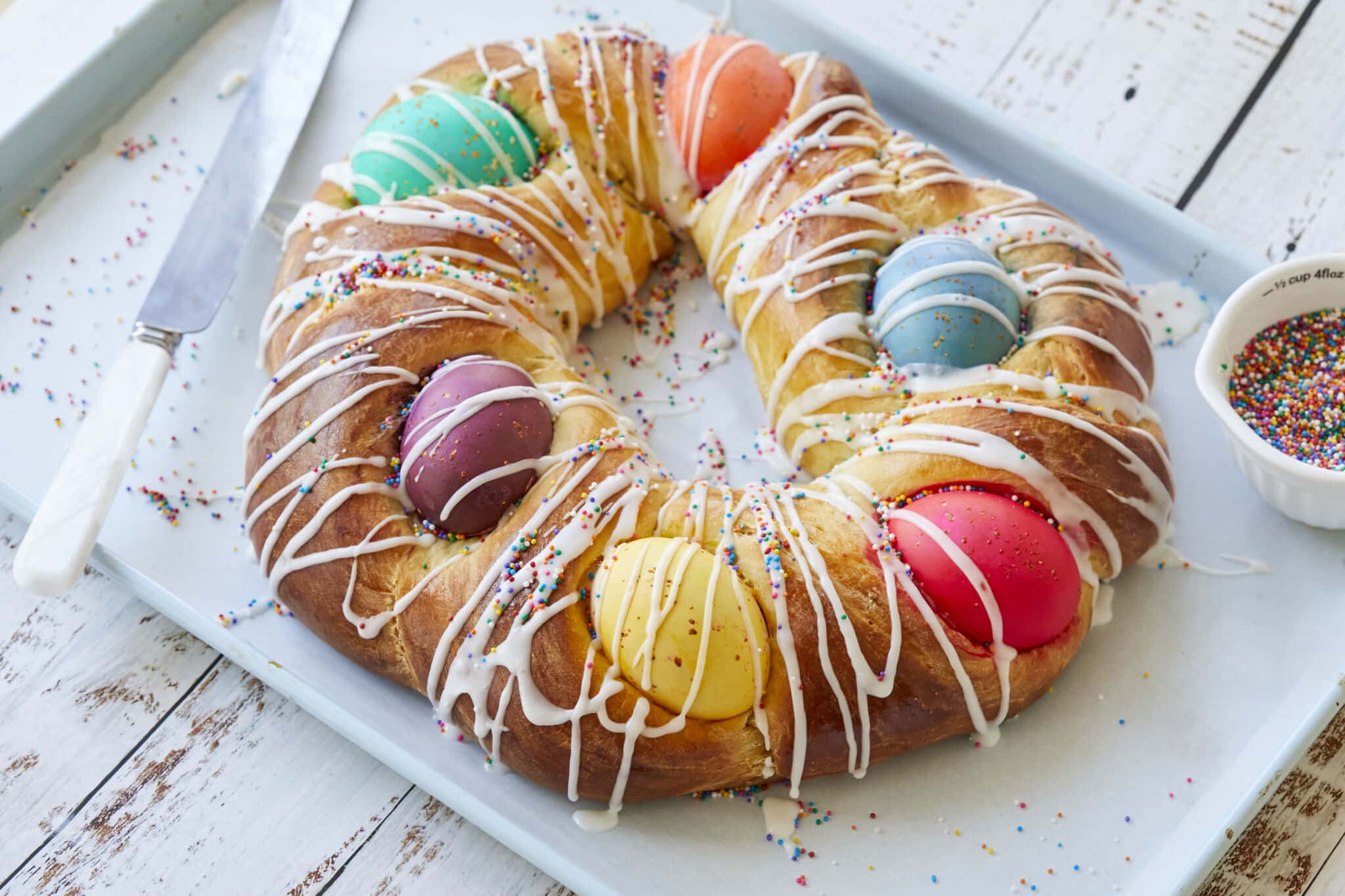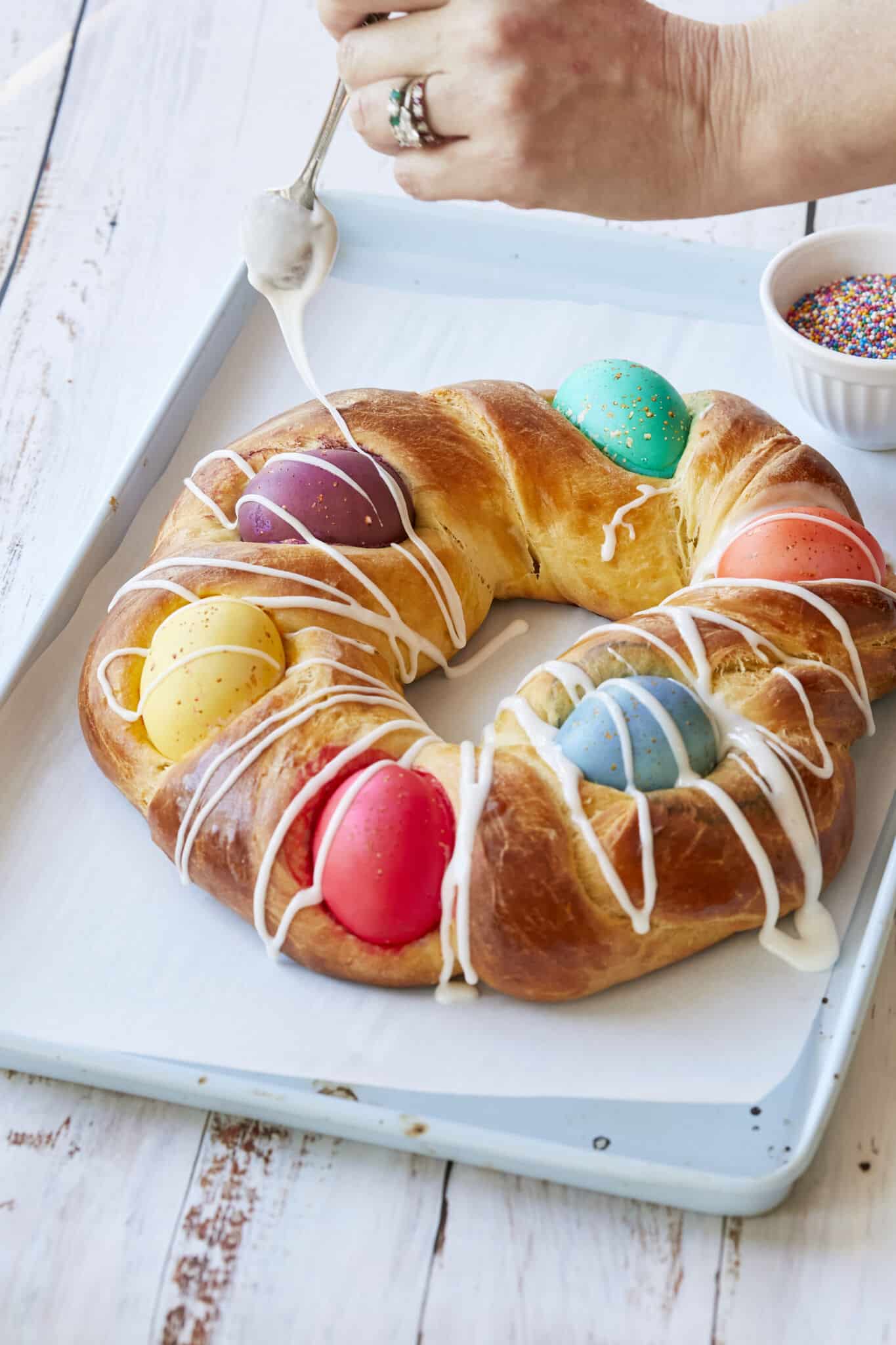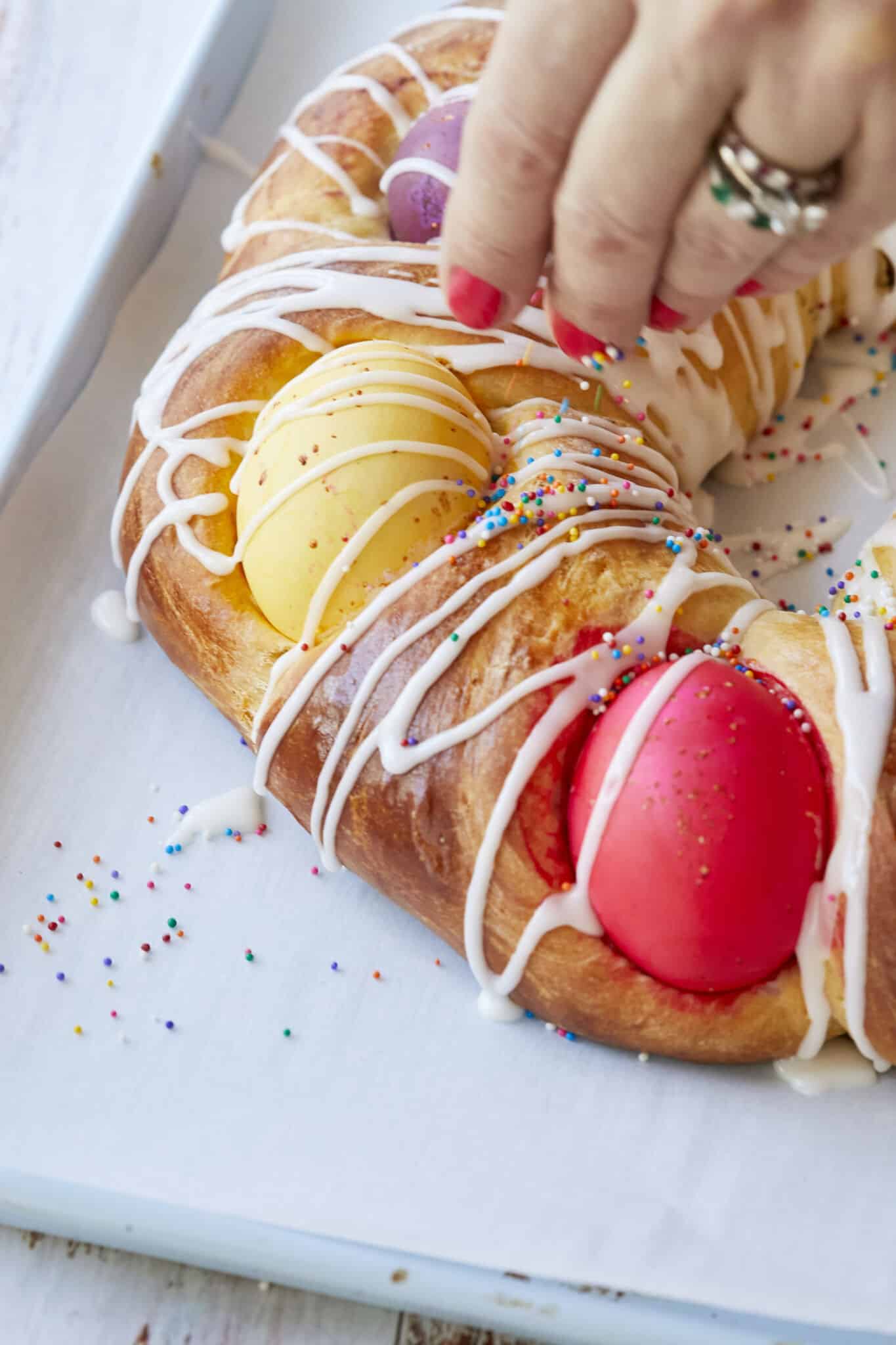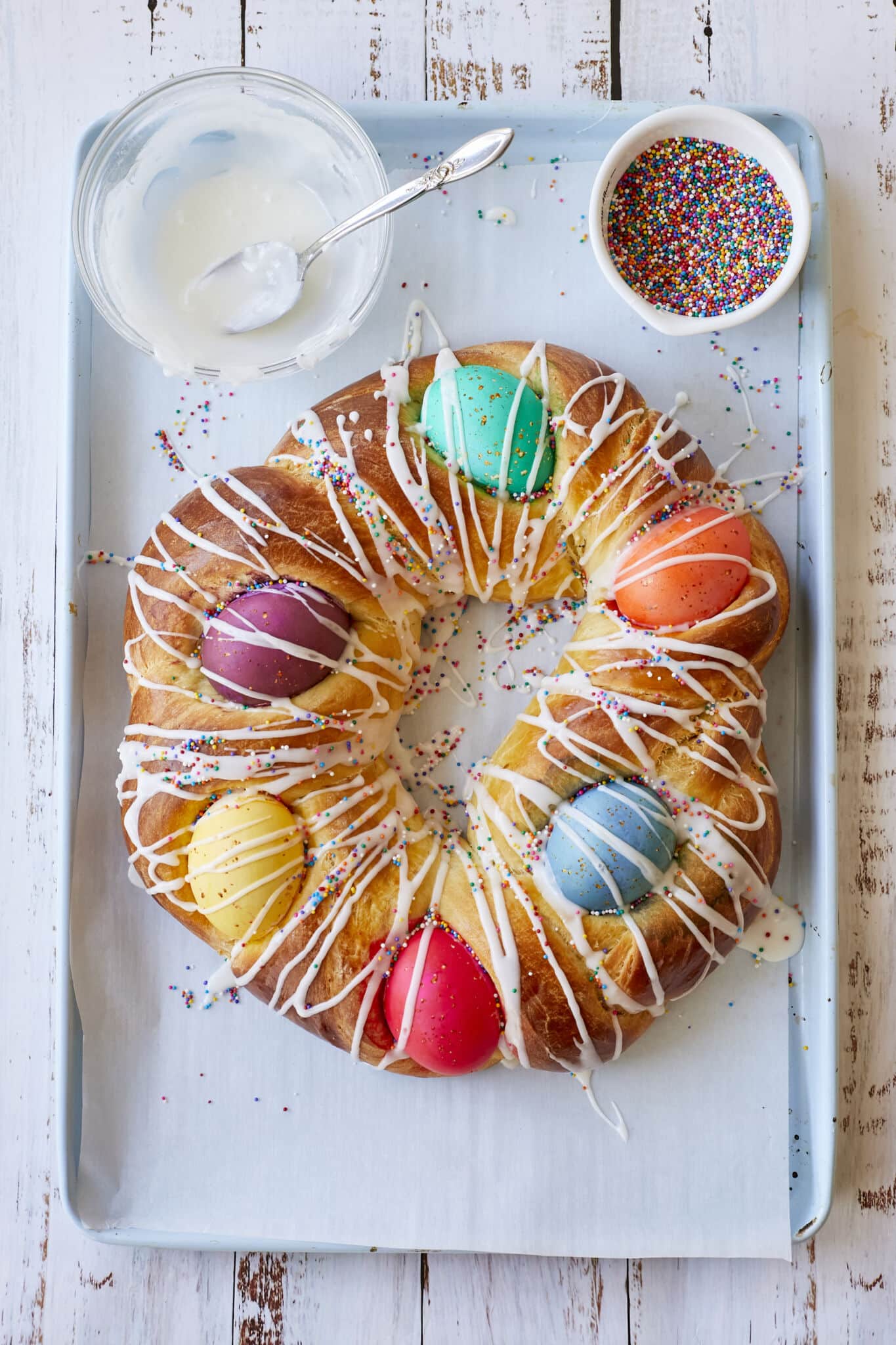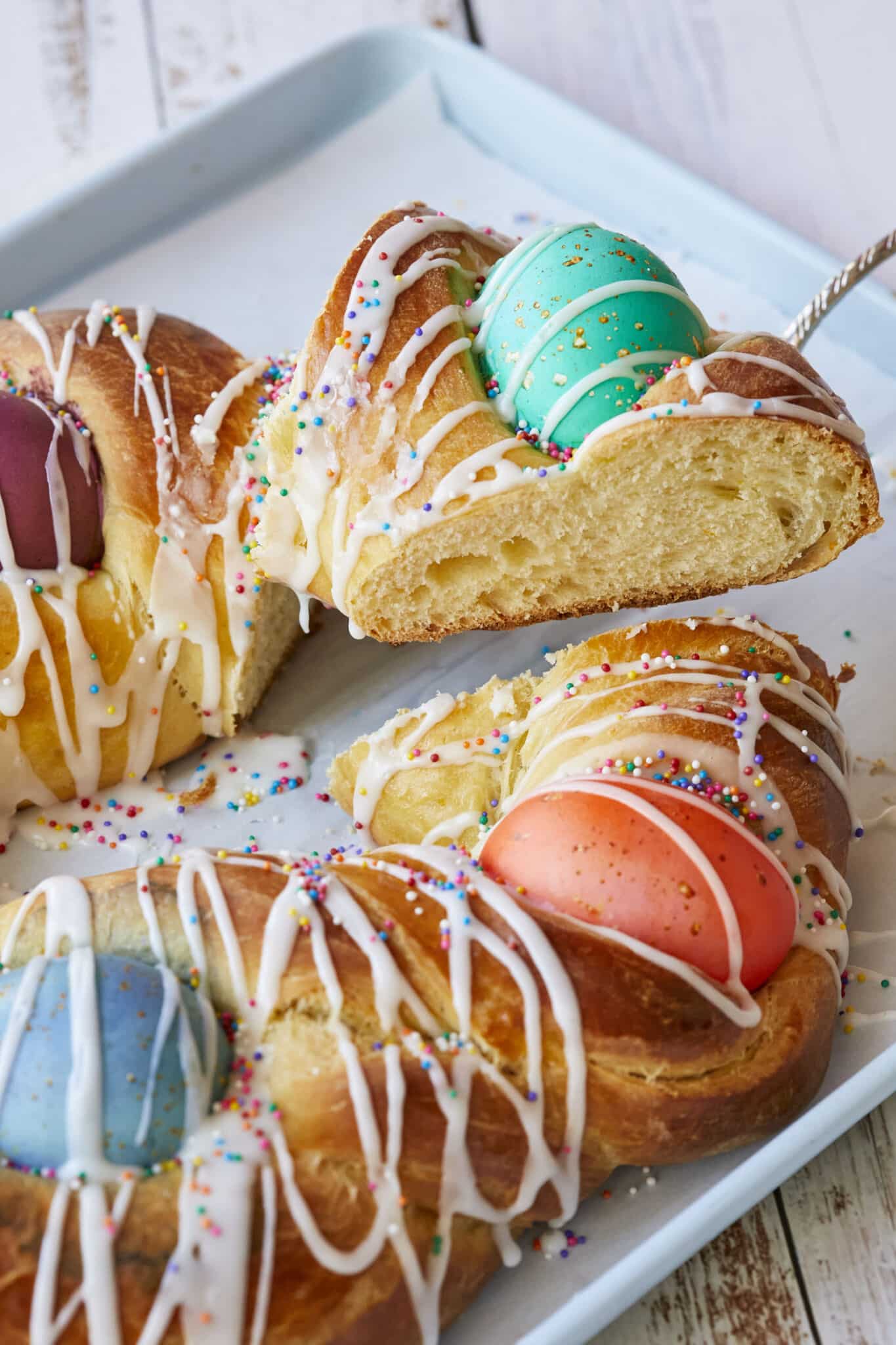Hi Bold Bakers! WHY YOU’LL LOVE THIS RECIPE: Our celebratory Traditional Italian Easter Bread (Pane di Pasqua) will delight with its enriched, brioche-like, lightly sweet dough and spring-perfect colorfully dyed eggs. It will be the star of your Easter dinner or any celebration! Already have an account?
This eggy bread undergoes a two-stage fermentation process that adds complexity and flavor. Orange and anise give the Pane di Pasqua brightness and a delightful aroma. Dyed raw eggs are placed on top and cooked along with the bread. A generous drizzle of glossy orange glaze is the irresistible final touch.
Easter is a big religious holiday in Ireland, and it’s also a celebration of spring and new life. In addition to the Easter symbols of lambs, chicks, and eggs, the Irish love their chocolate at Easter time! Bigger Bolder Baking is chock full of recipes perfect for celebrating Easter and the beauty of spring. You’ll love Easy Simnel Cake (Easter Fruitcake), Lemon Meringue Cake, and 5 Big and Bold Easter Recipes (including Chocolate Easter Eggs and Baby Chick Vanilla Cupcakes!)
Table of Contents
What is Traditional Italian Easter Bread (Pane di Pasqua)
Traditional Italian Easter Bread (Pane di Pasqua) is a brioche-like sweet bread formed and baked in a wreath shape. Festively-colored Easter eggs, glaze, and sprinkles adorn the top of the bread. This Pane di Pasqua is flavored with orange oil, zest, aniseed, and vanilla. This classic combination brings the sunny taste and fragrance of the Mediterranean to your holiday table. Forms of Easter bread go back centuries in Italy and contain religious symbolism. The wreath shape signifies the crown of thorns and is also seen as the circle of life. The eggs stand for rebirth and hope. Different regions have their own Italian Easter bread recipes with various flavorings like honey or lemon zest, or varieties of fruits and nuts.
Tools You Need for Italian Easter Bread
Mixing bowls Measuring cups Measuring spoons Glass measuring jug Kitchen scale (optional) Small bowls Wire rack Whisk Wooden spoon Stand mixer (optional) Tea towel or shower cap Baking sheet Parchment paper Rolling pin Plastic wrap (cling film) Pastry brush Aluminum foil
Key Ingredients for Italian Easter Bread and Why
For the colored eggs: Eggs Use white eggs here for beautifully vivid results. Vinegar Vinegar’s acidity reacts with the calcium carbonate in the eggshell. This makes a more porous surface for the dye to penetrate and bond with so the colors last. Food coloring Food coloring comes in liquid, gel, or coloring tablet form. For this recipe we found it best to use gel food dye for a much stronger color. For the sponge and the dough: All-purpose flour With a protein content of 9-11%, all-purpose flour creates the perfect chewy and soft texture. Granulated sugar Sugar feeds yeast, converting it into gas, making the dough rise and making the rolls light and airy. Sugar helps to retain moisture in the dough. Instant yeast Instant yeast does not require sponging and gives a quicker, more efficient rise than active dry yeast. If you use active dry yeast: for every teaspoon of instant yeast, use 1 ¼ teaspoons of active dry yeast. Bring the liquid in your recipe to blood temperature and mix in active dry yeast. Let it sit at room temperature for roughly 5 minutes until foam forms on top. Salt Salt enhances the flavor of the Easter bread and strengthens the gluten, giving it the perfect crumb. Salt also relaxes the dough so that it’s easier to shape. Eggs Using eggs yields plush, rich bread. For best results, get your refrigerated eggs to room temperature before you mix your dough. The egg wash (one egg mixed with a tablespoon of milk) gives the crust an attractive golden shine. Butter Butter contributes to the bread’s moisture, helping keep it soft and tender. Make sure your butter is softened correctly. Specifically, you’ll know it’s soft enough when you push the butter, and it makes an indent, but your finger doesn’t easily squish right through. Fiori di Sicilia Instead of Fiori di Sicilia you can use 1/4 teaspoon of each vanilla extract and orange oil that is commonly used in this bread. Aniseed These seeds from an anise plant have a slightly sweet licorice flavor. Aniseed gives Pane di Pasqua unique flavor, a delicious fragrance, and a slight crunch. For the glaze: Powdered sugar Powdered sugar, also called confectioners’ or icing sugar, is the main ingredient in the bread’s glossy glaze. Orange juice Sweet and bracing orange juice makes the glaze deeply flavorful. Sprinkles Sprinkles make this bread holiday-ready and echo the festive Easter egg colors.
How to Make Traditional Italian Easter Bread
Dye the eggs: Fill six small bowls with a cup of water, a teaspoon of vinegar, and six different shades of food coloring. Color the eggs in the food coloring for 10 to 15 minutes. If you want intense, vivid colors, keep them in longer. Dry on a wire rack and refrigerate until needed. Make the sponge: Combine flour, yeast, and water, cover with plastic wrap, and let sit at room temperature overnight. Mix the dough: The next day, using your stand mixer, combine the prepared sponge mixture with the other dough ingredients (flour, sugar, yeast, salt, butter, eggs, egg yolk, Fiori di Sicilia, orange zest, and aniseed) until you have a soft, smooth dough. Put the dough in an oiled bowl, cover, and let rise until doubled, about two hours. Shape the dough: Divide the dough in half, and shape each half into a 20-inch (50 cm) rope. Twist the ropes together and bring the ends together to make a circle. Cover and proof on a parchment-lined tray for 1 hour or until doubled. Bake the bread: Preheat the oven to 375°F (190°C). Carefully pull the ropes apart and nestle a dyed egg in the bread. Repeat around the wreath with the rest of the eggs. Brush the bread with egg wash (one egg whisked with one tablespoon of milk). Bake for 15 minutes. Lower the heat to 350°F (180°C) and bake for 20 more minutes until golden brown. Let the bread cool completely. Glaze the bread: Mix the powdered sugar with two tablespoons of milk. Add a few more milk if you want a thinner glaze. Drizzle over the bread and top with sprinkles.
Can I Make Traditional Italian Easter Bread in Advance?
Yes, you can make Traditional Italian Easter Bread in Advance.
The bread is best served on the day it’s baked, but you can prepare the dough two days in advance: Make the dough as directed. Transfer the mixed dough to an oiled bowl, cover with plastic wrap, and refrigerate. The refrigeration slows the yeast activity, and the dough can be refrigerated for up to two days. When ready to bake the bread, let it come to room temperature before shaping it. Follow the rest of the recipe as directed. Additionally, the eggs can be dyed up to two days before and refrigerated.
How to Store Traditional Italian Easter Bread
Store leftover bread in an airtight container at room temperature for up to two days.
What’s the purpose of making a sponge for Italian Easter Bread? A sponge is also called a starter, preferment, or pre-ferment. Using a sponge enhances the bread’s flavor and texture. Flour, yeast, and water are mixed and set aside to ferment. The sponge is mixed with the remaining ingredients to make the final dough. My dough seems too wet—how do I fix it? This brioche bread like dough is meant to be sticky. Its soft texture is what makes Pane di Pasqua so tender when baked. If it’s absolutely necessary, you can add a minimal amount of flour but use as little as possible. How do I ensure my Italian Easter Bread gets a perfect rise? If your dough didn’t rise, check whether your yeast is expired. Also, storing yeast in the fridge or freezer will keep it fresh longer. Salt does retard yeast growth, and in concentrations that are too high, it can kill the yeast. Keep salt and yeast separate, or mix each with flour first. Do not over-proof or under-proof the dough. The telltale sign you use is how your dough looks: if the dough has doubled in size, almost feels lighter but still strong, and a finger indent doesn’t spring back right away, then it’s ready.
Gemma’s Pro Chef Tips
This dough is very soft and sticky, which creates a very tender texture. It is best to use a stand mixer, as kneading by hand will be challenging. The eggs are not hard-boiled: they are raw, and bake in the oven along with the bread. Instead of the bread ring, you can make small, individual rolls instead: Dye ten eggs and divide the dough into ten equal portions. For each portion, divide the dough in half, shape each half into a rope, twist them together, and bring the ends together to form a small wreath. Nestle an egg in the center. The baking time may be a bit shorter, so keep a close eye on the bread while it’s baking. Instead of Fiori di Sicilia you can use a 1/4 teaspoon of each vanilla extract and orange oil that is commonly used in this bread.
More Festive Bread Recipes
Hot Cross Buns Recipe Incredible Chocolate Babka Recipe Best Ever Sticky Buns Recipe Rosca de Reyes Recipe Challah Bread Croatian Bishop’s Bread
